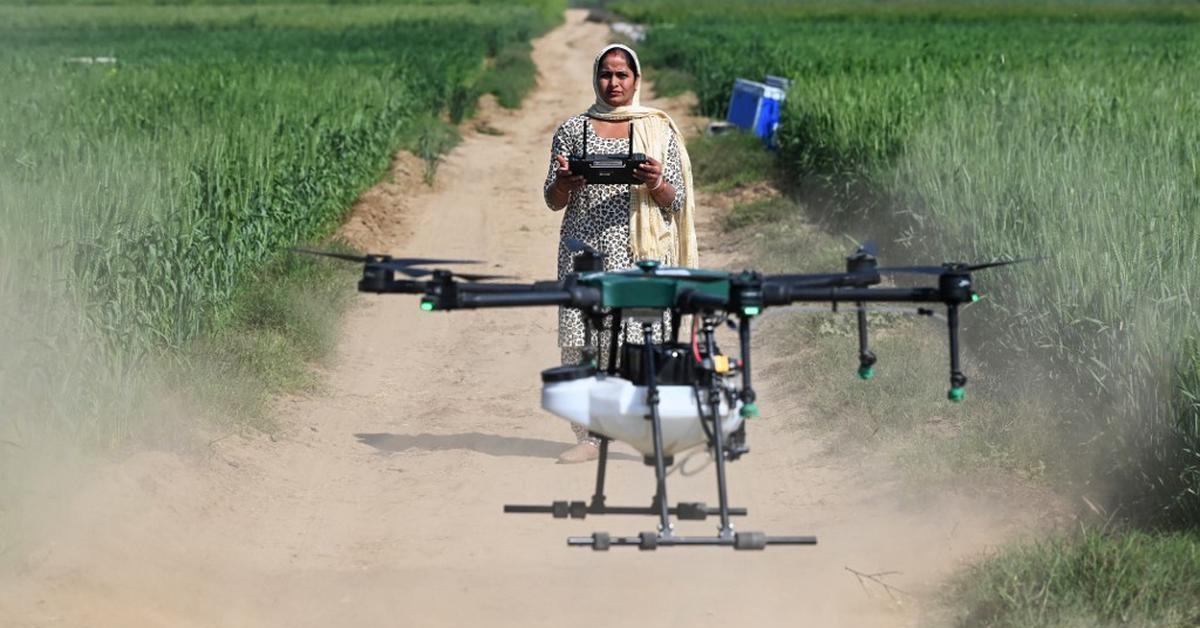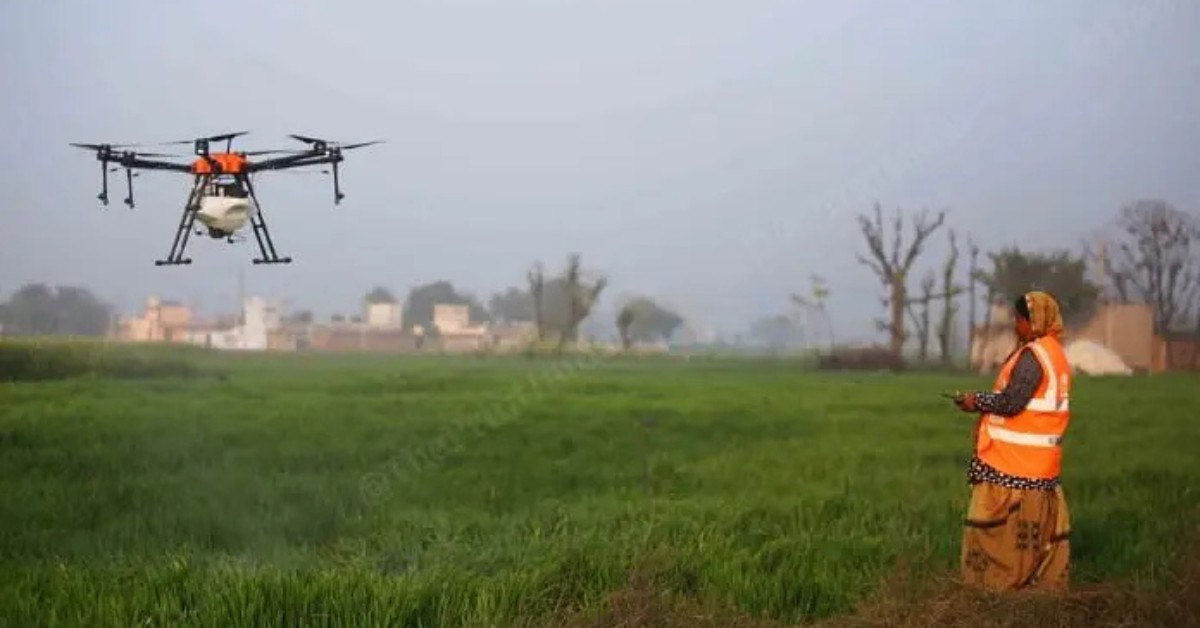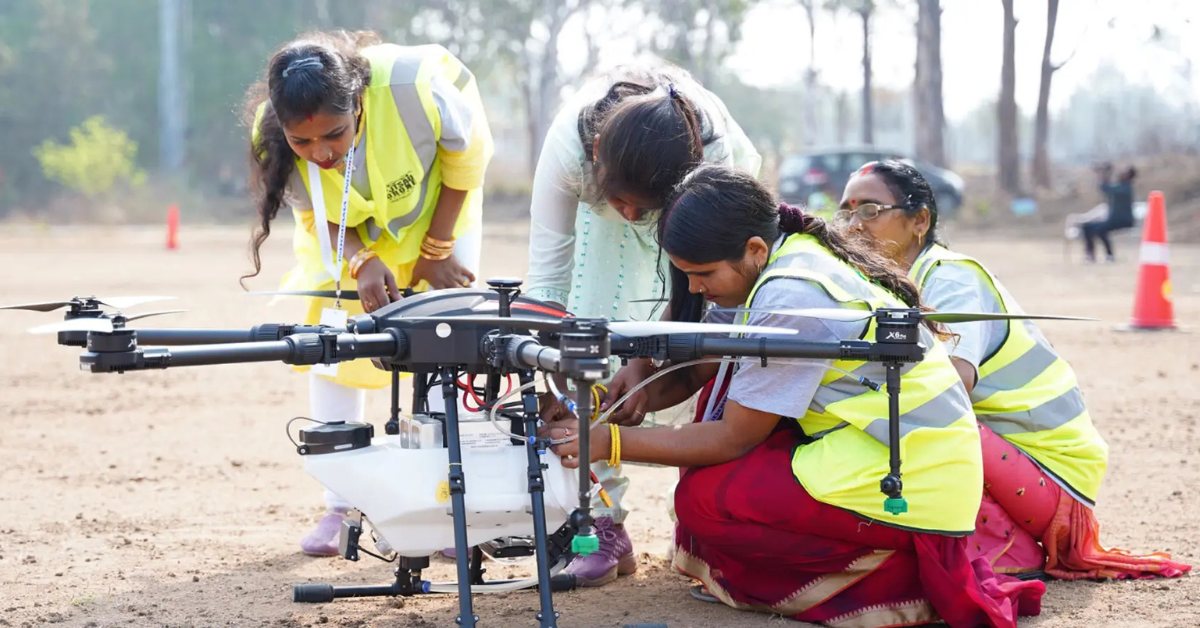Meet India’s Drone Didis: Women Farmers Earning Lakhs with Agri-Tech
In the fields of Pataudi, Haryana, the steady hum of a drone cuts through the quiet morning. Below, farmers pause to watch as 35-year-old Sharmila Yadav confidently navigates the skies — a former homemaker turned certified drone pilot.
Flying was always Sharmila’s dream. But she never imagined she’d be soaring over crops instead of clouds. With goggles on and controller in hand, she now sprays fertiliser with speed and precision, covering acres in minutes — a task that once took hours of manual labour.
Like many women farmers, Sharmila had spent years toiling under the sun with little recognition. But a training programme changed that. In just five weeks, she piloted drones across 150 acres, earning Rs 50,000 and a new title in her village: “pilot”.
Sharmila is among a growing number of rural women rewriting what farming looks like — thanks in part to government-backed efforts like the Drone Didi programme that are opening up skies, and futures.
1. Sharmila Yadav – Pataudi, Haryana
Who she is: Sharmila Yadav, 35, spent years as a homemaker in the rural town of Pataudi. But she always held a humble dream of flying — one she never thought would materialise in the middle of a farmland.
What she did: Thanks to the government’s ‘Drone Didi’ initiative, she became one of the first certified women drone pilots in her area. Today, she helps spray fertiliser across vast fields with speed and accuracy.
 A single drone can spray 1 acre in just 7 minutes, drastically reducing labour time and chemical exposure for farmers. Picture source: AFP
A single drone can spray 1 acre in just 7 minutes, drastically reducing labour time and chemical exposure for farmers. Picture source: AFP
How she did it: Sharmila enrolled for training with Drone Destination and the Indian Farmers Fertiliser Cooperative Limited (IFFCO). She spent weeks studying both theory and practical skills, learning how to handle agri-drones confidently.
The impact: In just five weeks, Sharmila completed spraying over 150 acres — twice — and earned nearly Rs 50,000. Her proudest reward? The respect of her community, who now call her “pilot” with admiration and pride. As she breaks gender barriers with each drone flight, she is also lifting others with her.
2. Nisha Solanki – Haryana’s first certified woman drone pilot
Who she is: A trailblazing farmer from Haryana, Nisha Solanki holds the distinction of being the first woman in the state certified by the Directorate General of Civil Aviation (DGCA) to pilot agricultural drones.
What she did: Nisha didn’t stop at certification — she became a mentor and guide, training hundreds of farmers across Haryana and promoting the use of drones to improve farming efficiency.
How she did it: After receiving formal drone pilot certification, she began conducting live demonstrations on how drones could be used to spray pesticides quickly and efficiently. With every session, her confidence — and her impact — grew.
The impact: Nisha has now conducted over 750 demonstrations, helping farmers reduce water usage by up to 90 percent and cutting spraying time to just five minutes per acre. Her journey from local farmer to state-wide changemaker is lighting the way for many.
3. Varanasi’s ‘Drone Didi’ Collective – Uttar Pradesh
Who they are: In Varanasi, a spirited group of nine rural women came together to form a drone service team — each of them trained to handle agricultural drones with care and confidence.
What they did: As a collective, they began offering spraying services across farms in their region. Their drones are capable of spraying 10 litres of pesticide in 10 minutes, making the process efficient and far less labour-intensive.
 Each Drone Didi is provided with a high-capacity agricultural drone worth up to Rs 10 lakh. Representational picture source: The Print
Each Drone Didi is provided with a high-capacity agricultural drone worth up to Rs 10 lakh. Representational picture source: The Print
How they did it: The women underwent comprehensive training at the Drone Academy of Professor Jayashankar Telangana State Agricultural University, learning everything from drone operation to safety and maintenance.
The impact: In just 10 months, the team covered over 2,500 acres and earned Rs 3.38 lakh. But their true success lies in how they have reduced labour costs for local farmers, ensured more precise pesticide use, and proven that rural women can be at the forefront of agri-tech innovation.
4. Women farmers from Punjab & Haryana
Who they are: More than 20 women from across villages in Punjab and Haryana have stepped forward to embrace technology and change the face of farming in their communities.
What they did: They trained to become professional drone pilots and now offer services like pesticide and fertiliser spraying, often in regions where mechanised solutions were once unheard of.
How they did it: With training from institutions like the Manesar Drone Kendra and support from central government schemes, these women gained both technical skills and financial support to begin offering their services independently.
 The government subsidises up to Rs 10 lakh for drone equipment under the scheme, enabling women-led FPOs and SHGs to access the tech. Picture source: Yourstory
The government subsidises up to Rs 10 lakh for drone equipment under the scheme, enabling women-led FPOs and SHGs to access the tech. Picture source: Yourstory
The impact: Earning between Rs 200 and Rs 250 per acre for spraying services, they’ve made drone technology both accessible and affordable. With each acre they fly over, they are saving time, increasing efficiency, and proving that women can be powerful tech leaders in agriculture.
5. Lakhpati didis of Chhattisgarh – scaling profits and yields
Who they are: Across the tribal regions of Chhattisgarh, 15 women farmers have emerged as change agents — proudly known as “Lakhpati Didis” — thanks to their work with agricultural drones.
What they did: These women began offering drone spraying services to local farmers, covering over 500 acres of farmland in the process and improving productivity across the board.
How they did it: Supported by the state’s Lakhpati Didi scheme, they were given access to agri-drones, technical training, and guidance on how to set up their own service operations.
The impact: Each woman has earned around Rs 1 lakh annually. The farmers they support have seen tangible results: crop yields rose from 24 to 30 quintals per acre, and profits increased by nearly 15 percent. Their story is a powerful example of how grassroots women-led initiatives can bring about large-scale impact.
Edited by Khushi Arora
News